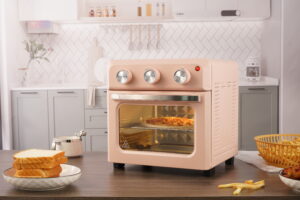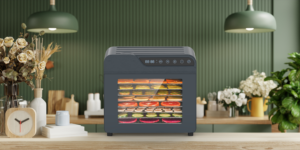As the Sales Manager at Foshan Linden Intelligent Appliances Co., Ltd., I’ve had the pleasure of helping food enthusiasts and health-conscious cooks find the perfect kitchen appliances. Based in China, our factory produces high-quality food dehydrators, alongside our 12L, 16L, and 30L air fryer ovens and air fryers, which we export to North America, Europe, Russia, and the Middle East. A question I often hear is: Which type of food dehydrator is best for home use? I’m excited to share my expertise and guide you through the world of fruit and food dehydrators to find the one that suits your lifestyle.
In this article, I’ll compare different types of food dehydrators—stackable, shelf, and box models—focusing on performance, design, and practicality. Drawing from our experience at Linden, where we craft innovative appliances with customizable features, I’ll help you choose the perfect dehydrator for your home. Let’s dive in and explore the art of dehydrating!
What Is a Food Dehydrator?
A food dehydrator is a specialized appliance that removes moisture from food, preserving it for longer storage. It’s perfect for making dried fruits, vegetables, herbs, jerky, and even snacks like fruit leather. At Linden, our food dehydrators are designed to deliver consistent results, helping you create healthy, preservative-free snacks at home.
How Does a Food Dehydrator Work?
Food dehydrators use a heating element and a fan to circulate warm air over food. This gentle process evaporates moisture, preserving nutrients and flavor. According to WebMD, dehydrated foods retain most of their nutritional value, making them a healthy snack option. Our dehydrators allow you to adjust temperatures for different foods, ensuring optimal results.
Benefits of Food Dehydrators
- Healthy Snacking: Preserves food without additives or excess sugar.
- Versatility: Dries fruits, vegetables, herbs, meats, and more.
- Cost Savings: Reduces food waste by preserving leftovers or bulk produce.
- Customizable Features: Offers adjustable settings for precise drying.
- Compact Design: Fits easily in most kitchens.
Types of Food Dehydrators
There are three main types of food dehydrators: stackable, shelf, and box. Each has unique features, and I’ve seen buyers at trade shows and on our website, lindensmart.com, weigh these options carefully. Let’s break them down.
Stackable Food Dehydrators
Stackable dehydrators feature vertical trays that stack on top of each other. The heating element and fan are usually at the bottom or top, pushing air through the trays. These are the most common and affordable type for home use.
Pros of Stackable Dehydrators
- Affordable: Typically the least expensive option.
- Compact: Easy to store, ideal for small kitchens.
- Expandable: Add or remove trays to adjust capacity.
- Simple to Use: Straightforward controls for beginners.
Cons of Stackable Dehydrators
- Uneven Drying: Trays closer to the heat source may dry faster, requiring rotation.
- Smaller Capacity: Limited space for large batches.
- Basic Features: May lack advanced temperature controls.
Shelf Food Dehydrators
Shelf dehydrators, also called tray or horizontal dehydrators, have a box-like structure with slide-out trays. The fan and heating element are usually at the back, providing horizontal airflow. These are popular for more serious home dehydrators.
Pros of Shelf Dehydrators
- Even Drying: Horizontal airflow ensures consistent results across all trays.
- Larger Capacity: Handles bigger batches, great for families.
- Advanced Features: Often includes precise temperature controls and timers.
- Versatility: Suitable for a wide range of foods, including delicate herbs.
Cons of Shelf Dehydrators
- Higher Cost: More expensive than stackable models.
- Larger Footprint: Takes up more counter or storage space.
- Complex Cleaning: More parts to clean compared to stackable units.
Box Food Dehydrators
Box dehydrators are heavy-duty, often commercial-grade appliances with a cabinet-like design. They offer large capacity and robust features, making them ideal for avid home cooks or small businesses. At Linden, our food dehydrators lean toward this style, combining durability with user-friendly controls.
Pros of Box Dehydrators
- High Capacity: Perfect for bulk drying or large families.
- Consistent Results: Powerful fans ensure uniform drying.
- Durable Build: Designed for frequent, heavy use.
- Customizable Settings: Precise controls for various foods.
Cons of Box Dehydrators
- Expensive: Higher price point than other types.
- Bulky: Requires significant space in your kitchen.
- Overkill for Casual Use: May be too much for occasional dehydrating.
Key Factors to Consider When Choosing a Food Dehydrator
Choosing the right food dehydrator depends on your needs. Here are the key factors I’ve seen buyers prioritize when visiting our booth at trade shows or browsing our website.
Capacity and Space
Consider how much food you plan to dehydrate. Stackable dehydrators are great for small batches, like drying a few apples or herbs. Shelf and box dehydrators, like our Linden models, handle larger quantities, making them ideal for preserving garden harvests or bulk produce. If kitchen space is tight, a stackable model is more practical due to its compact design.
Drying Performance
Even drying is crucial for consistent results. Stackable dehydrators may require tray rotation to avoid uneven drying, as noted by Consumer Reports. Shelf and box dehydrators, with their horizontal airflow, provide more uniform drying, which is why our Linden dehydrators use this technology for professional-grade results.
Ease of Use
I love appliances that make life easier. Stackable dehydrators are simple to operate, with basic controls perfect for beginners. Shelf and box models, like ours at Linden, offer advanced features like digital timers and adjustable thermostats, giving you more control over the drying process.
Health Benefits
Dehydrating preserves nutrients without the need for added sugars or preservatives. According to Healthline, dehydrated foods retain most vitamins and minerals, making them a healthy snack option. All dehydrator types support this, but box and shelf models allow for more precise temperature settings to protect delicate nutrients in foods like herbs.
Design and Aesthetics
At Linden, we design our food dehydrators with style in mind. Our models come in sleek, modern finishes or warm tones to complement any kitchen. Stackable dehydrators are functional but less visually appealing, while shelf and box models often have a more polished look.
Energy Efficiency
Energy consumption matters for cost and sustainability. Stackable dehydrators use less power, around 0.4–0.6 kWh per use, per Energy Star. Shelf and box dehydrators use slightly more, around 0.6–1 kWh, but their efficiency for large batches can offset this. Our Linden dehydrators are designed to balance power use with performance.
Cost and Maintenance
Stackable dehydrators are the most budget-friendly, ideal for casual users. Shelf and box dehydrators, like our premium models, have a higher upfront cost but offer durability and advanced features. Maintenance is straightforward for all types, with removable trays or baskets for easy cleaning.
When to Choose a Stackable Food Dehydrator
I recommend a stackable dehydrator if you:
- Are new to dehydrating and want an affordable option.
- Have limited kitchen space.
- Plan to dry small batches of fruits, vegetables, or herbs.
- Prefer simple, no-frills operation.
- Want an appliance that’s easy to store.
Stackable models are perfect for beginners or occasional users who value simplicity.
When to Choose a Shelf Food Dehydrator
A shelf dehydrator is ideal if you:
- Want consistent drying without rotating trays.
- Dry larger quantities of food regularly.
- Need precise temperature controls for delicate foods.
- Value versatility for a range of recipes.
- Have space for a slightly larger appliance.
These are great for intermediate users who dehydrate frequently.
When to Choose a Box Food Dehydrator
I suggest a box dehydrator if you:
- Process large batches of food, like garden harvests.
- Want professional-grade results at home.
- Need durable, long-lasting equipment.
- Require advanced features like timers and thermostats.
- Have ample kitchen or storage space.
Our Linden food dehydrators fall into this category, offering robust performance for serious home cooks.
Can You Combine Dehydrators with Other Appliances?
I often tell buyers that a food dehydrator pairs beautifully with other kitchen appliances, like our air fryer ovens. For example, you can dehydrate fruit slices in our food dehydrator and use our 16L air fryer oven to bake healthy granola. This combo maximizes your kitchen’s potential for healthy, homemade snacks.
Quality and Certifications
Quality is our top priority at Linden. Our food dehydrators undergo rigorous testing and meet international standards like UL and CE, ensuring safety and reliability for global markets. When choosing any dehydrator, check for certifications to guarantee performance and durability.
Logistics and Practical Tips
From my experience with buyers worldwide, logistics matter. Our food dehydrators are lightweight and easy to ship, making them popular for international orders. Stackable models are the most portable, while box dehydrators require more space. At Linden, we streamline production to meet tight delivery schedules.
SEO-Friendly Tips for Choosing Your Food Dehydrator
To help you decide, here are some tips optimized for search terms like “best food dehydrators” or “home food dehydrator”:
- Assess Your Needs: Decide on batch size and frequency of use.
- Check Energy Use: Look for efficient models to save on power.
- Consider Design: Choose a dehydrator that matches your kitchen aesthetic.
- Read Reviews: Explore feedback on platforms like CNET for insights.
- Visit Trade Shows: Test dehydrators in person for hands-on experience.
Final Thoughts: Which Food Dehydrator Is Right for You?
As someone who’s passionate about healthy, innovative cooking, I believe food dehydrators are a game-changer for home kitchens. Stackable models are great for beginners with limited space. Shelf dehydrators offer a balance of capacity and precision. Box dehydrators, like our Linden models, are perfect for serious cooks who want professional results. Your choice depends on your budget, kitchen space, and dehydrating goals.
Ready to start preserving your favorite foods? Visit lindensmart.com to explore our food dehydrators, or email me at sales4@fslinden.com for personalized advice. Let’s make healthy snacking simple and delicious!
Meta Title: Best Food Dehydrators: Which Type for Home Use?
Meta Description: Compare stackable, shelf, and box food dehydrators to find the best for your home. Learn about performance, design, and health benefits.



